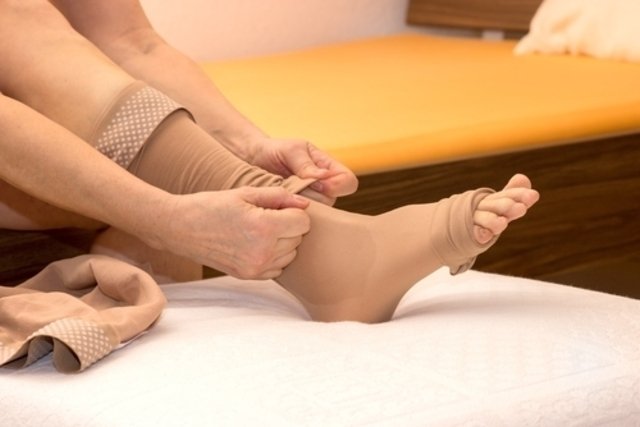Any surgery can increase the risk of developing thrombosis, as it is common to remain still for a long time both during and after the procedure, which impairs circulation. The risk of thrombosis is greater in the postoperative period of complex surgery or surgery that takes more than 30 minutes, such as chest, heart or abdominal surgery, such as bariatric surgery, for example.
Therefore, to avoid thrombosis after surgery, it is recommended to start taking short walks right after the doctor’s approval, wear elastic stockings for about 10 days or until it is possible to walk normally again, move your legs and feet while is lying down and taking anticoagulant medicines to prevent clots from forming. Also check all the care after surgery.
Thrombosis is the formation of clots or thrombi within blood vessels, preventing blood flow. Find out more about thrombosis.

What to do
To prevent thrombosis after surgery, your doctor may recommend:
1. Walk as soon as possible
The operated patient should walk as soon as there is little pain and there is no risk of the scar breaking, as movement stimulates blood circulation and reduces the risk of blood clots. Normally, the patient can walk after 2 days, but it depends on the surgery and the doctor’s advice.
2. Wear elastic stockings
The doctor may recommend the use of elastic compression stockings even before surgery, which should be used for a period of around 10 to 20 days, until the body’s movement throughout the day returns to normal and it is possible to carry out activities. physical, removed only for body hygiene.
The most commonly used stocking is medium compression, which exerts a pressure of around 18-21 mmHg, which is capable of compressing the skin and stimulating venous return, but the doctor may also recommend high compression elastic stockings, with pressure between 20-30 mmHg, in certain cases of higher risk, such as people with thick or advanced varicose veins, for example.
Elastic stockings are also advisable for anyone who has venous circulation problems, people who are bedridden, who undergo bed-bound treatments or who have neurological or orthopedic diseases that make movement difficult. Find out more details on what compression socks are for and when to use them.
3. Elevate your legs
This technique facilitates the return of blood to the heart, which prevents the accumulation of blood in the legs and feet, in addition to reducing leg swelling.
When possible, the patient is advised to move their feet and legs, bending and stretching about 3 times a day. These exercises can be guided by the physiotherapist while still in the hospital.
4. Use anticoagulant medications
Medicines that help prevent the formation of clots or thrombi, such as injectable Heparin, which may be recommended by the doctor, especially when it involves a lengthy surgery or one that will require long rest, such as abdominal, thoracic or orthopedic surgery.
The use of anticoagulants may be indicated until it is possible to walk and move the body normally. These remedies are also usually indicated during a hospital stay or during treatment in which the person needs to rest or lie down for a long time. Understand better the function of these medicines, what anticoagulants are and what they are for.
5. Massage your legs
Performing a leg massage every 3 hours, with almond oil or any other massage gel, is also another technique that stimulates venous return and hinders the accumulation of blood and the formation of clots.
In addition, motor physiotherapy and other procedures that may be recommended by the doctor, such as electrical stimulation of calf muscles and intermittent external pneumatic compression, which is done with devices that stimulate blood movements, especially in people who are unable to move of the legs, like patients in a coma.
Who is most at risk of having a thrombosis after surgery
The risk of thrombosis occurring after surgery is highest when the patient is over 60 years old, especially elderly people who are bedridden, after accidents or strokes, for example. However, other factors that may increase the risk of deep vein thrombosis after surgery are:
- Surgery performed with general or epidural anesthesia;
- Obesity;
- Smoking;
- Use of contraceptives or other hormone replacement therapies;
- Having cancer or undergoing chemotherapy;
- Being a carrier of type A blood;
- Have heart disease, such as heart failure, varicose veins or blood problems such as thrombophilia;
- Surgery performed during pregnancy or shortly after birth;
- If there is a generalized infection during surgery.
When a thrombus forms due to surgery, there is a high chance of developing pulmonary embolism, as the clots reduce or obstruct the passage of blood and lodge in the lungs, a situation that is serious and causes a risk of death.
In addition, swelling, varicose veins and brownish skin on the legs can also occur, which in more serious cases can lead to gangrene, which is the death of cells due to lack of blood.

Sign up for our newsletter and stay up to date with exclusive news
that can transform your routine!
Warning: Undefined array key "title" in /home/storelat/public_html/wp-content/plugins/link-whisper-premium/templates/frontend/related-posts.php on line 12
Warning: Undefined array key "title_tag" in /home/storelat/public_html/wp-content/plugins/link-whisper-premium/templates/frontend/related-posts.php on line 13



